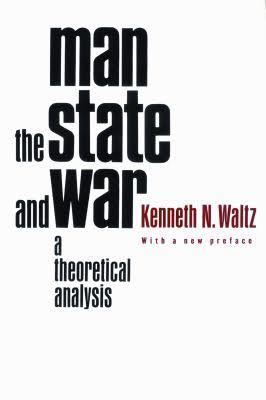8 /10 1 Votes8
Language English Originally published 1959 Country United States of America | 4/5 Goodreads Preceded by N/A | |||||||||||||||||||||||||||||||||
 | ||||||||||||||||||||||||||||||||||
Genre International relations theory Followed by Foreign policy and democratic politics Similar Kenneth Waltz books, International law books | ||||||||||||||||||||||||||||||||||
Man, the State, and War is a 1959 book on international relations by realist academic Kenneth Waltz. The book is influential within the field of international relations theory for establishing the three 'images of analysis' used to explain conflict in the international system.
Contents
Waltz's three images of international relations
Waltz's initial contribution to the field of international relations was his 1959 book, Man, the State, and War, which classified theories of the causes of war into three categories, or levels of analysis. Waltz refers to these levels of analysis as "images," and uses the writings of one or more classic political philosophers to outline the major points of each image. Each image is given two chapters: the first mainly uses the classical philosopher's writings to describe what that image says about the cause of war; the second usually consists of Waltz analyzing the strengths and weaknesses of that image.
First image: Individuals
The first image argues that wars are often caused by the nature of particular statesmen and political leaders such as state leaders -- examples like Napoleon or Saddam Hussein -- or by human nature more generally. This is basically consistent with Classical Realism, which dominated the International Relations discipline at the time of Man, the State, and War but which Waltz would contest more fully in his next book, Theory of International Politics.
Second image: States
Theories of war that fall under the rubric of Waltz's second image contend that wars are caused by the domestic makeup of states. A prime example that Waltz refers to is Lenin's theory of imperialism, which posits that the main cause of war is rooted in the need for capitalist states to continue opening up new markets in order to perpetuate their economic system at home. A more familiar example in the Western world today is the notion that non-democratic states, because of their internal composition, start wars.
Third image: International system
Waltz next assesses the first two images as being less influential in general than the third image, yet ultimately necessary in understanding the causes of War. Waltz concludes his 1959 book Man, the State, and War with a final explanation of the three images. The third image describing the framework of world politics and the first and second, determining the forces that create the policies of a state. The third image posits that the cause of war is found at the systemic level; namely, that the anarchic structure of the international system is the root cause of war. In this context, "anarchy" is not defined as a condition of chaos or disorder but rather one in which there is no sovereign body that governs the interactions between autonomous nation-states. Put differently, unlike in domestic society where citizens can theoretically rely on law enforcement agencies to protect their persons and property, if a state is invaded and calls "911" it can't be sure anyone will answer. Similarly, whereas when two citizens have a dispute they can appeal to the courts to render a verdict and, more importantly, the law enforcement agencies to enforce the court's ruling, there is no body above nation-states that is capable of: establishing rules or laws for all the states, deciding how these apply in specific cases, and compelling the states to honor the court's ruling. As a result, if an issue at stake is important enough to a state, it can achieve a satisfactory outcome only by using its power to impose its will on another state(s). The realization that, at any point in time any state can resort to armed force, forces each state always be prepared for that contingency. These themes are fleshed out more fully in Theory of International Politics which, as the title suggests, lays out a theory for international politics as a whole rather than the narrower focus on what causes war.
